And, we’re back.
Spring is in the air, and other than drive around with the windows down, filling out tournament brackets is at the top of our I Want To Do That lists. So that’s what we’re doing, and you’re invited to join us.
What college basketball has ingrained in our culture, we’ve brought to you with an automotive twist. It’s Year 4 for Muscle Car Match-Ups. Last year, we expanded the 16-car field to 32 and introduced late-models from the 1980s through today.
To keep things fresh, we added an additional spin this year: We invited some hot rods to the party. The older hot rods chosen for our bracket are arguably the forefathers of the muscle car, helping to pave the way for the original muscle car era of the 1960s and 70s. And they all had a distinctive style like no other!
How do you choose between a 1969 Yenko 427 Chevy Nova and a 1950 Olds Rocket Holiday 88? How do you choose between the 2015 Dodge Challenger Hellcat and the 1933 Ford Deluxe?
THAT IS TOTALLY UP TO YOU.
No rules. Pick one or the other, and it doesn’t matter why. The reason: “Because I like it better!” is perfectly sufficient for us.
Whatever happens next is up to you. Let’s get started.
How it Works
We’ll present our entire bracket as first-round match-ups below (Editor’s Note: Yes, we know some great cars didn’t make the cut—you try narrowing it to just 32). You can vote for your first round winners in one of three ways:
- Write all your first round picks in the comments section below.
- Follow OnAllCylinders on Facebook and vote on each individual match-up when we post it. You make your pick by commenting on your favorite.
- Follow Summit Racing Equipment’s Facebook page. Our friends at Summit Racing will post individual, head-to-head match-ups from the tournament, and you can comment on your favorite to vote.
1970 Chevy 454 Chevelle SS vs. 1962 Dodge Polara 413 Max Wedge
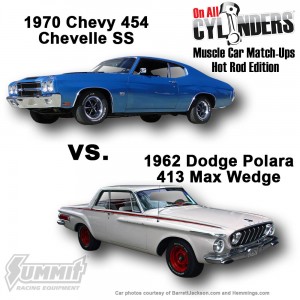 When GM lifted its ban on 400-plus cubic-inch motors in mid-sized cars, Chevrolet responded in a big way. Its popular Chevelle SS model was now available with a 454-cubic-inch engine, and an LS6 option gave the Chevelle 454 SS 450 horsepower. At the time, it was one of the most powerful production vehicles that anyone could purchase.
When GM lifted its ban on 400-plus cubic-inch motors in mid-sized cars, Chevrolet responded in a big way. Its popular Chevelle SS model was now available with a 454-cubic-inch engine, and an LS6 option gave the Chevelle 454 SS 450 horsepower. At the time, it was one of the most powerful production vehicles that anyone could purchase.
The 413 V8 Max Wedge engine was Dodge’s answer to the Chevy 409 and Pontiac’s 421 Super Duty in competition on the Super Stock drag race circuit of the 1960s. Used in tandem with the A-727 Torqueflite three-speed automatic transmission, it became a favorite inside the 1962 Dodge Polara. The Polara shared body and chassis components with the Dodge Dart.
1969 Ford Mustang Boss 429 vs. 1964 Pontiac GTO
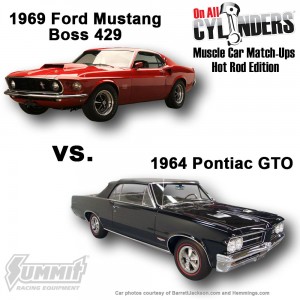 Rare but undeniably awesome, the 1969 Ford Boss 429 featured Ford’s 429 cubic-inch engine (go figure). The engine was developed for NASCAR use and built to compete with Mopar’s popular HEMI engine. In the end, only 859 Boss 429s were made, and the car remains highly collect-able.
Rare but undeniably awesome, the 1969 Ford Boss 429 featured Ford’s 429 cubic-inch engine (go figure). The engine was developed for NASCAR use and built to compete with Mopar’s popular HEMI engine. In the end, only 859 Boss 429s were made, and the car remains highly collect-able.
Widely credited as the car that ushered in the entire muscle car era, the 1964 GTO was actually an option package for the Tempest and sported a 389 cubic inch engine that put out 325 horsepower. While earlier cars like the Polara Max Wedge and Pontiac 421 SD had muscle, the 1964 GTO launched an entire movement of yoked up automobiles!
1964 Olds Cutlass 442 vs. 1941 Willys
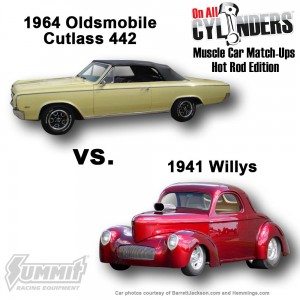 Four years before the 442 became a beloved model in its own right, it was first introduced in 1964 as an option package for the Cutlass and F-85 models. The 1964 Oldsmobile Cutlass 442 got its name from the presence of the four-barrel carburetor, four-speed manual transmission, and dual exhaust. And it kept its name by winning a lot of races.
Four years before the 442 became a beloved model in its own right, it was first introduced in 1964 as an option package for the Cutlass and F-85 models. The 1964 Oldsmobile Cutlass 442 got its name from the presence of the four-barrel carburetor, four-speed manual transmission, and dual exhaust. And it kept its name by winning a lot of races.
In its stock state, the ’41 Willys was equipped with a weak and failure-prone four-cylinder Go-Devil engine. Because the 1941 Willys Americar has been devoid of viable factory replacement parts for most of its existence, it has become a favorite of hot rodders, everywhere. What happens when a hot-rodded ’41 Willys squares off with another vehicle is up to the builder.
1969 Pontiac GTO (The Judge) vs. 1955 Chrysler C-300
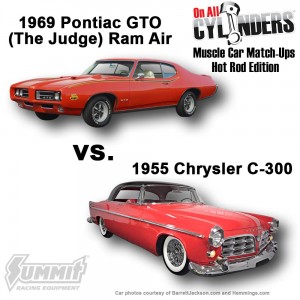 Perhaps no muscle car better reflected American culture than the 1969 Pontiac GTO “the Judge” model, which was named after a popular comedy routine on Rowan & Martin’s Laugh-In. The Judge had a serious vibe, though, thanks to its standard 400 H.O. Ram Air III engine, Rally II wheels, spoiler, and wide tires.
Perhaps no muscle car better reflected American culture than the 1969 Pontiac GTO “the Judge” model, which was named after a popular comedy routine on Rowan & Martin’s Laugh-In. The Judge had a serious vibe, though, thanks to its standard 400 H.O. Ram Air III engine, Rally II wheels, spoiler, and wide tires.
The 1955 Chrysler C-300, powered by a 5.4L HEMI, was bred for NASCAR racing and was dubbed at launch as “the world’s fastest stock car.” Just 1,725 were built for the street, making it a not-often-seen head-turner, and a total prize for any car collector.
1970 Buick GSX vs. 1963 Ford Thunderbird M-Code
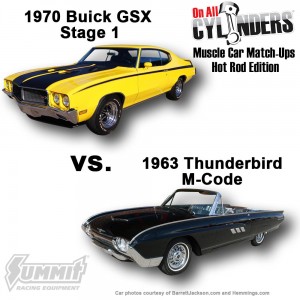 Buick combined luxury with muscle. The 1970 Buick GSX was the high performance package for the Gran Sport and featured a stout 455 cubic-inch engine. The Stage 1 version used a more aggressive cam and higher compression for even greater output.
Buick combined luxury with muscle. The 1970 Buick GSX was the high performance package for the Gran Sport and featured a stout 455 cubic-inch engine. The Stage 1 version used a more aggressive cam and higher compression for even greater output.
We have a soft spot for scarcity. Just 455 1963 Ford Thunderbird Sports Roadsters were produced. Among them were the even-rarer M-Codes, a small group of Thunderbirds powered by 390-cubic-inch Tri-Power V8 engines which kicked out 340 horsepower at the crankshaft. The cars were designated with the letter “M” in the VIN. These were Fords that, at the time, the Chevy Corvette wanted no part of. And in the history of American performance, that’s a pretty rare thing.
1973 Trans Am SD-455 vs. 1968 Hurst Olds
 The Illustrated Directory of Muscle Cars calls it “the last great American muscle car.” The 1973 Pontiac Trans Am Super Duty 455, according to many observers, was the bookend to Pontiac’s creation of the muscle car era with the ’64 Goat. It was a bad machine forged during an era of strict emission standards and stood alone atop the performance car category until the Z/28 Camaro re-emerged in 1977.
The Illustrated Directory of Muscle Cars calls it “the last great American muscle car.” The 1973 Pontiac Trans Am Super Duty 455, according to many observers, was the bookend to Pontiac’s creation of the muscle car era with the ’64 Goat. It was a bad machine forged during an era of strict emission standards and stood alone atop the performance car category until the Z/28 Camaro re-emerged in 1977.
The 1968 Hurst/Olds is sometimes called a “gentleman’s hot rod” due to its combination of luxury and high performance emanating from its 390-horsepower, 455-cubic-inch big block V8. The ’68 Hurst/Olds is a rare find and total torque monster out for blood.
1957 Chevy Corvette vs. 1959 Plymouth Sport Fury
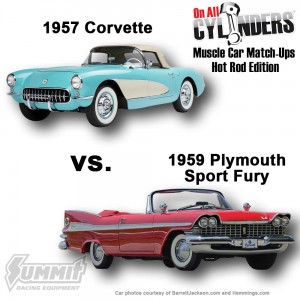 The 1957 Corvette was the first to feature Chevy’s “Ramjet” fuel injection in a 283 V8 engine that was among the first automotive engines to produce one horsepower for every cubic inch (the Chrysler 300 series was the first). Only 1,040 ’57 Corvettes were manufactured with fuel injection.
The 1957 Corvette was the first to feature Chevy’s “Ramjet” fuel injection in a 283 V8 engine that was among the first automotive engines to produce one horsepower for every cubic inch (the Chrysler 300 series was the first). Only 1,040 ’57 Corvettes were manufactured with fuel injection.
The heavily re-styled 1959 Plymouth Sport Fury features those massive tailfins consistent with the iconic automotive designs of the late-’50s, and was considered a luxury/performance hybrid at the very top of the Plymouth line. Hot rodders love this classic. It was available in two performance V8 engine packages—the “Sport Fury” V8, with 260 horsepower and the “Golden Commando” V8, with 305 horsepower and enough torque generation to require a beefier transmission.
1969 Dodge Charger R/T vs. 1962 Catalina 421 Super Duty
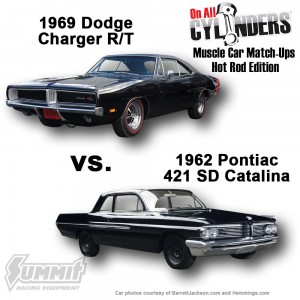 The 1969 Charger reached legendary status on its own, but earned cult status when Bo and Luke piloted a ’69 Charger on TV’s Dukes of Hazzard. We went with the 1969 Charger R/T because of its standard 440-cubic-inch engine and special handling package. (A 426 was also optional.)
The 1969 Charger reached legendary status on its own, but earned cult status when Bo and Luke piloted a ’69 Charger on TV’s Dukes of Hazzard. We went with the 1969 Charger R/T because of its standard 440-cubic-inch engine and special handling package. (A 426 was also optional.)
According to The Illustrated Directory of Muscle Cars, the 1962 Pontiac Catalina 421 Super Duty was “designed to do battle on dragstrips and Stock Car tracks… it was never meant for polite society.” In 1962, nothing beat a Super Duty Pontiac. Not the 406 Fords. Not the 409 Chevys. Nothing.
1969 Chevy Yenko 427 Nova vs. 1949 Mercury
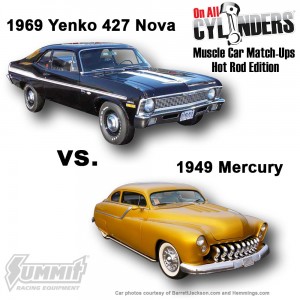 The ’69 Yenko Nova was the lightest in the famed Yenko 427 lineup and could go zero to 60 miles-per-hour in an astonishing four seconds! Only 37 of these 425-horsepower beasts were built. That’s bad news for performance junkies—and probably good news for society at large!
The ’69 Yenko Nova was the lightest in the famed Yenko 427 lineup and could go zero to 60 miles-per-hour in an astonishing four seconds! Only 37 of these 425-horsepower beasts were built. That’s bad news for performance junkies—and probably good news for society at large!
The 1949 Mercury changed the game when that first Eight hit showroom floors. The body styling set the stage for modern automotive design, and in ’49, was credited for record-breaking sales figures for both Mercury and Ford vehicles. Customizers didn’t take long to get to work. Sam Barris built the original “lead sled” from a ’49 Merc, and later the famed “Hirohata Merc” which is credited for launching a new generation of custom car builders.
1965 Shelby Cobra 427 vs. 1968 Corvette L88
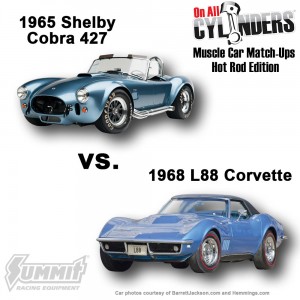 The only car in our brackets to combine American muscle with European styling, the 1965 Shelby Cobra 427 brought together a roadster body with a 510-horsepower, 427-cubic-inch “side-oiler” V8. The Carroll Shelby creation remains one of the quickest cars ever built.
The only car in our brackets to combine American muscle with European styling, the 1965 Shelby Cobra 427 brought together a roadster body with a 510-horsepower, 427-cubic-inch “side-oiler” V8. The Carroll Shelby creation remains one of the quickest cars ever built.
There were only 80 built. Almost everyone loves rare things, and when something’s packing a 427, do you really want to argue with it? The 1968 Chevrolet Corvette L88 produced more than 500 horsepower. Without a fan shroud, choke, or heating system, it could eclipse 600 horses. In 1968! Giddy up.
1970 Plymouth Superbird vs. 1968 1/2 Ford Mustang Cobra Jet
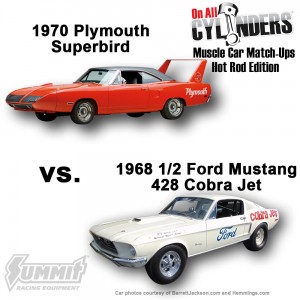 It was a car fit for a king. A Road Runner turned missile. Plymouth modeled the 1970 Superbird after the 1969 Dodge Daytona which was the first-ever car to crack the 200-mile-per-hour barrier in NASCAR. Because of their rarity, Superbirds sell for small fortunes at auction today. Only 1,935 were built. Just 135 were outfitted with the 426 HEMI.
It was a car fit for a king. A Road Runner turned missile. Plymouth modeled the 1970 Superbird after the 1969 Dodge Daytona which was the first-ever car to crack the 200-mile-per-hour barrier in NASCAR. Because of their rarity, Superbirds sell for small fortunes at auction today. Only 1,935 were built. Just 135 were outfitted with the 426 HEMI.
Following the lead of Rhode Island car dealer Robert Tasca, who crammed a 428 Police Interceptor motor into a Mustang, Ford created the 428 Cobra Jet Mustang to compete with the big block Camaros and Firebirds of the day. Using a passenger car 428 engine, 427 low-riser heads, and Tasca’s 735 Holley carb, Ford created the legendary 428 Cobra Jet for mid-year 1968. It wreaked havoc on the NHRA circuit—particularly in Super Stock.
2015 Dodge Challenger Hellcat vs. 1967 Mercury Cyclone 427
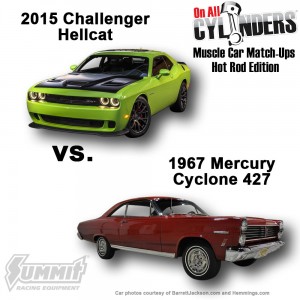 What can we say about the Challenger Hellcat that hasn’t already been said? Dodge basically went nuclear on the current Big Three muscle car war when it unleashed this 707-horsepower Hellcat engine last year. The Hellcat-powered Challenger, with its retro looks, would undoubtedly create havoc on the streets in any era of American performance.
What can we say about the Challenger Hellcat that hasn’t already been said? Dodge basically went nuclear on the current Big Three muscle car war when it unleashed this 707-horsepower Hellcat engine last year. The Hellcat-powered Challenger, with its retro looks, would undoubtedly create havoc on the streets in any era of American performance.
Have you ever seen a 1967 Mercury Cyclone 427 up close? Chances are you haven’t. And that’s one of the things that make this ultra-rare muscle car cool. Only eight Cyclones were produced with the 410-horse, single-carb 427 FE engine in 1967, making it the rarest of the cars in our competition. It featured Ford’s already-feared 427 engine—a legend in its own right. The 1967 Mercury Cyclone 427 gave the Mercury brand instant performance cred.
1970 Plymouth HEMI ‘Cuda vs. 2013 Shelby GT500
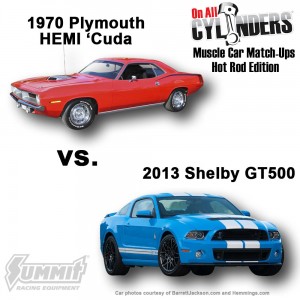 The 1970 Plymouth HEMI ‘Cuda was once commemorated on a special U.S. Postal Service stamp—and for good reason. The 1970 HEMI ‘Cuda featured Mopar’s brand new E-body, incorporated the almighty HEMI engine, and came standard with a distinctive shaker scoop.
The 1970 Plymouth HEMI ‘Cuda was once commemorated on a special U.S. Postal Service stamp—and for good reason. The 1970 HEMI ‘Cuda featured Mopar’s brand new E-body, incorporated the almighty HEMI engine, and came standard with a distinctive shaker scoop.
We lost automotive performance legend Carroll Shelby in 2012. His swan song? The 2013 Shelby GT500, SAE-certified at 662 horsepower and 631 ft.-lbs. of torque. At the time, it packed the most-powerful production V8 engine in the world. Top speed? More than 200 miles-per-hour. It’s okay. We want one, too.
1955 Chevy Bel Air vs. 1933 Ford Deluxe
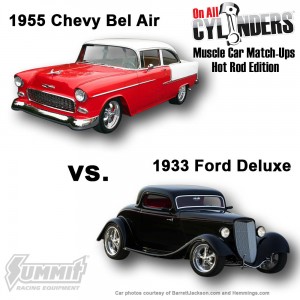 It’s the first of the Tri-Fives and the first V8-powered Chevy to have commercial success. It is arguably the most-iconic American car in history. It introduced overhead valve design with a small block engine so popular that you can still buy new versions of basically that same design today. It’s the ’55 Chevy. And in the world of hot rodding, it bows down to nothing.
It’s the first of the Tri-Fives and the first V8-powered Chevy to have commercial success. It is arguably the most-iconic American car in history. It introduced overhead valve design with a small block engine so popular that you can still buy new versions of basically that same design today. It’s the ’55 Chevy. And in the world of hot rodding, it bows down to nothing.
Ford introduced its first-ever V8 engine in 1932. The famed Ford flathead kicked out just 75 horsepower in the 1933 Ford Deluxe; however, the small-bodied car combined with the “big” V8 engine has some auto historians calling it America’s first muscle car. By 1934, some of America’s most notorious criminals, like John Dillinger, as well as Bonnie and Clyde, were using these speedy Fords to outrun law enforcement after bank heists. So, in a way, Henry Ford is responsible for creating the FBI.
1970 Dodge Challenger R/T vs. 1950 Olds Rocket Holiday 88
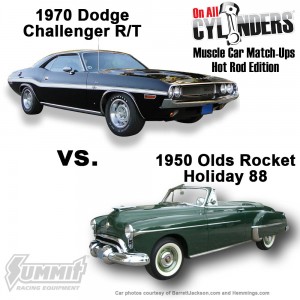 The Dodge Challenger R/T arrived late to the muscle car game, but it came in with a loud roar. It was available with some of Mopar’s most potent powerplants, starting with the 383. The 440 and 426 HEMI engine were also options.
The Dodge Challenger R/T arrived late to the muscle car game, but it came in with a loud roar. It was available with some of Mopar’s most potent powerplants, starting with the 383. The 440 and 426 HEMI engine were also options.
The high-compression, overhead-valve Rocket V8 engine showed up in 1949, and in 1950, tucked inside a Rocket 88, won 10 out of 19 NASCAR stock car races. It also broke the class speed record at Daytona! The 1950 Oldsmobile Rocket Holiday 88, according to The Illustrated Directory of Muscle Cars, is considered by many to be America’s first post-war muscle car.
1969 Chevrolet Camaro ZL1 vs. 1969 AMC Hurst SC/Rambler
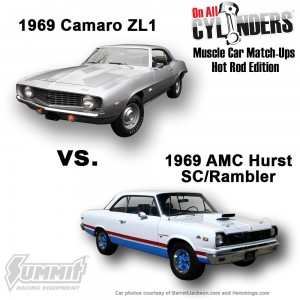 Extremely rare and highly powerful, the Camaro ZL1 is considered by most Chevrolet enthusiasts to be the holy grail of the popular Camaro line. Its all-aluminum 427-cubic-inch engine was rated at 435 horsepower (although many experts say it actually made over 500 horses), yet weighed about the same as a small block 327. Although they were barely street cars, they were backed by a 5-year/50,000-mile warranty.
Extremely rare and highly powerful, the Camaro ZL1 is considered by most Chevrolet enthusiasts to be the holy grail of the popular Camaro line. Its all-aluminum 427-cubic-inch engine was rated at 435 horsepower (although many experts say it actually made over 500 horses), yet weighed about the same as a small block 327. Although they were barely street cars, they were backed by a 5-year/50,000-mile warranty.
The AMC Hurst SC/Rambler brought together fun and fast like no other car of its era. From the unforgettable “AIR” lettering on the hood scoop to the distinctive 390 Cu. In. label on the hood, the Hurst SC/Rambler and its patriotic paint scheme were unmistakable. So was its performance. A combination of 390 cubic inches of big block power and just 3,100 pounds made it a formidable track star.

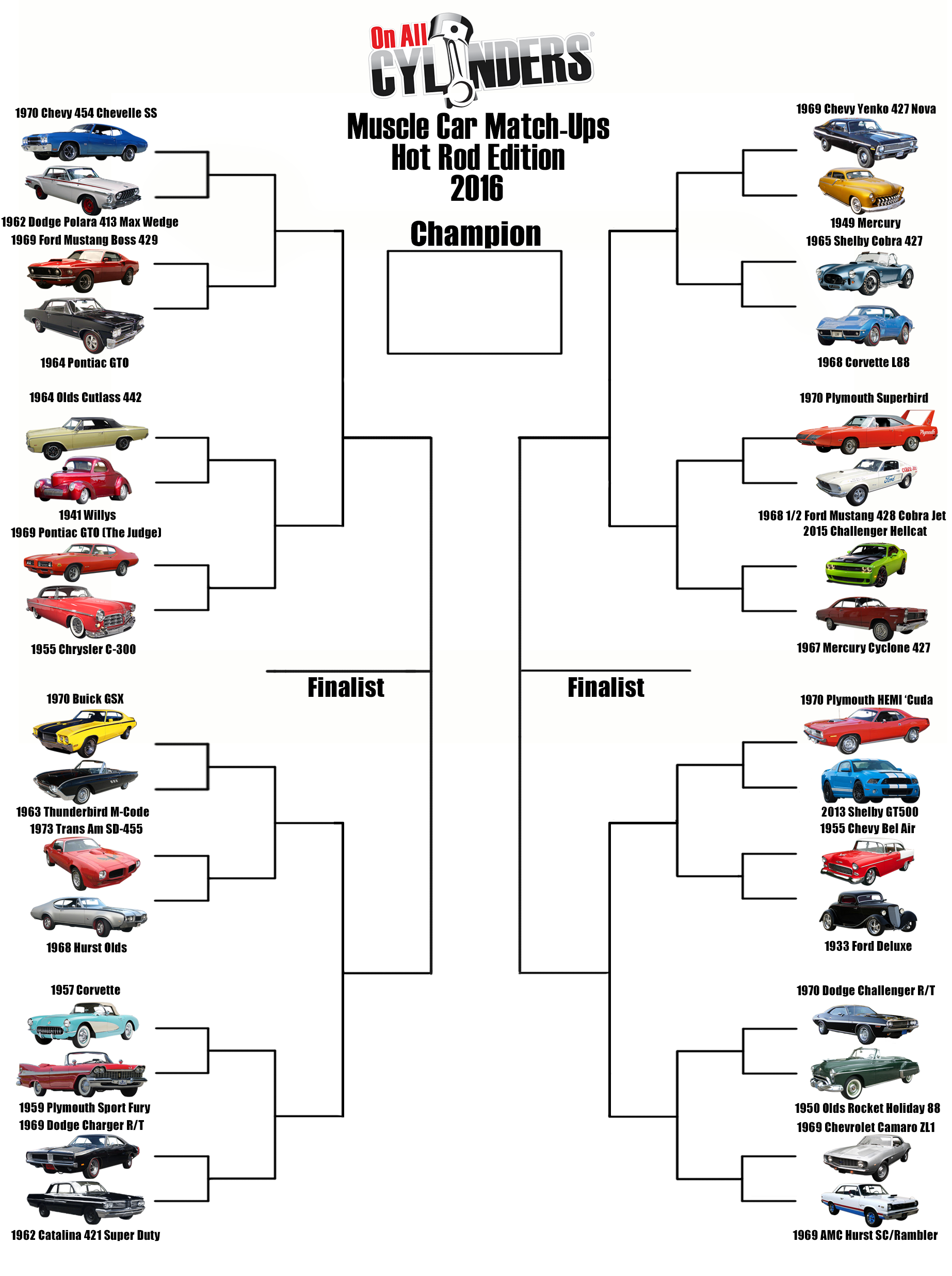
70 Chevelle, 64 GTO, 64 442, 69 GTO, 63 T-bird,68 Olds, 57 Vette,62 Catalina, 49 Mercury, 65 Shelby, 70 Superbird, 67 Mercury, 70 Cuda, 55 Bell Air, 50 Rocket 88, 69 AMC Rambler
Chevelle,64 GTO,442,69 GTO, Buick GSX, Trans Am,57 Vette, Charger, Yenko Nova, Cobra, Superbird, Hellcat, Hemi Cuda, 55 BelAir, 70 Challenger, 69 ZL1
Some of the picks may not be technically right or factual – I owned a 1970 SCJ 429 Ford and the 1969 Mustang only came with a 428 . The 1970 Mustang was the first year for the 429 SCJ Mustang that was offered to the general public.
He-are My Picks —– 1962 Pontiac 421 SD Catalina — 1963 Thunderbird M code — 1933 Ford Deluxe —1967 Mercury Cyclone — 1965 Shelby Cobra 427 —2015 Challenger Hellcat and last but not lease — The Shelby Cobra 427
Chevelle & Yenko Nova.
62 Polara, 69 BOSS429, 41 Willys, 55 C-300, 70 GSX, 68 Olds Rocket, 57 Corvette, 62 Catalina, 49 Mercury, 65 Cobra, 68 Cobra Jet, 15 Hellcat, 70 Cuda, 33 Deluxe, 70 Challenger, 1969 AMC Hurst SC/Rambler!
They’re all winners
[…] the perfect bracket. Oh, you thought we were talking about basketball, didn’t you? Fat chance! On All Cylinders has released their 4th Muscle Car Match Up. The Hot Rod Edition 2016 is freshly out, and we are […]
[…] Stay tuned as Muscle Car Match-Ups (Hot Rod Edition) rolls on. And don’t forget to review our original post for details on how to vote! […]
[…] Stay tuned as Muscle Car Match-Ups (Hot Rod Edition) rolls on. And don’t forget to review our original post for details on how to vote! […]
[…] Car Match-Ups (Hot Rod Edition) rolls on with the championship round slated for Monday. You can review our original post for details on how to vote, then let your voice be […]
In this day and age, why do you make it so difficult to vote? Just post the brackets with a selection box by each, and cast votes by tapping box beside each preferred choice!